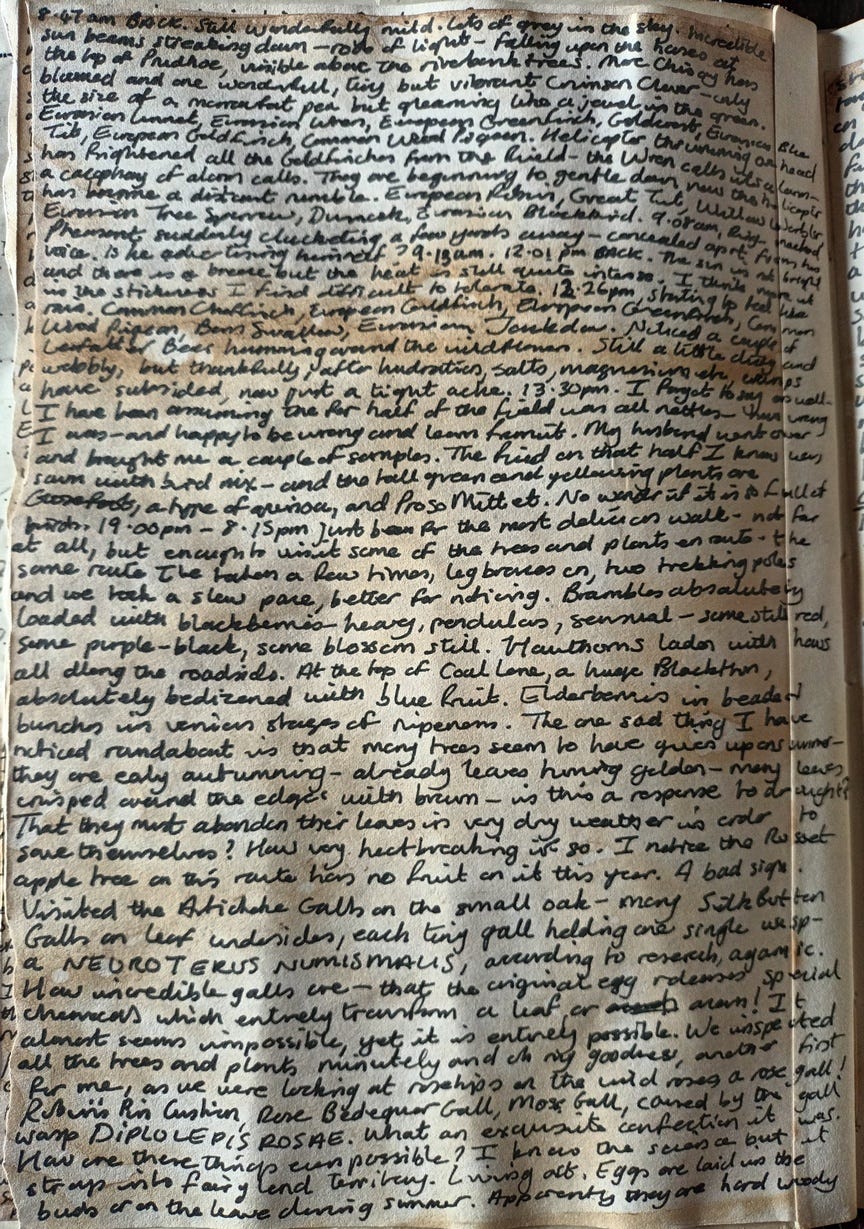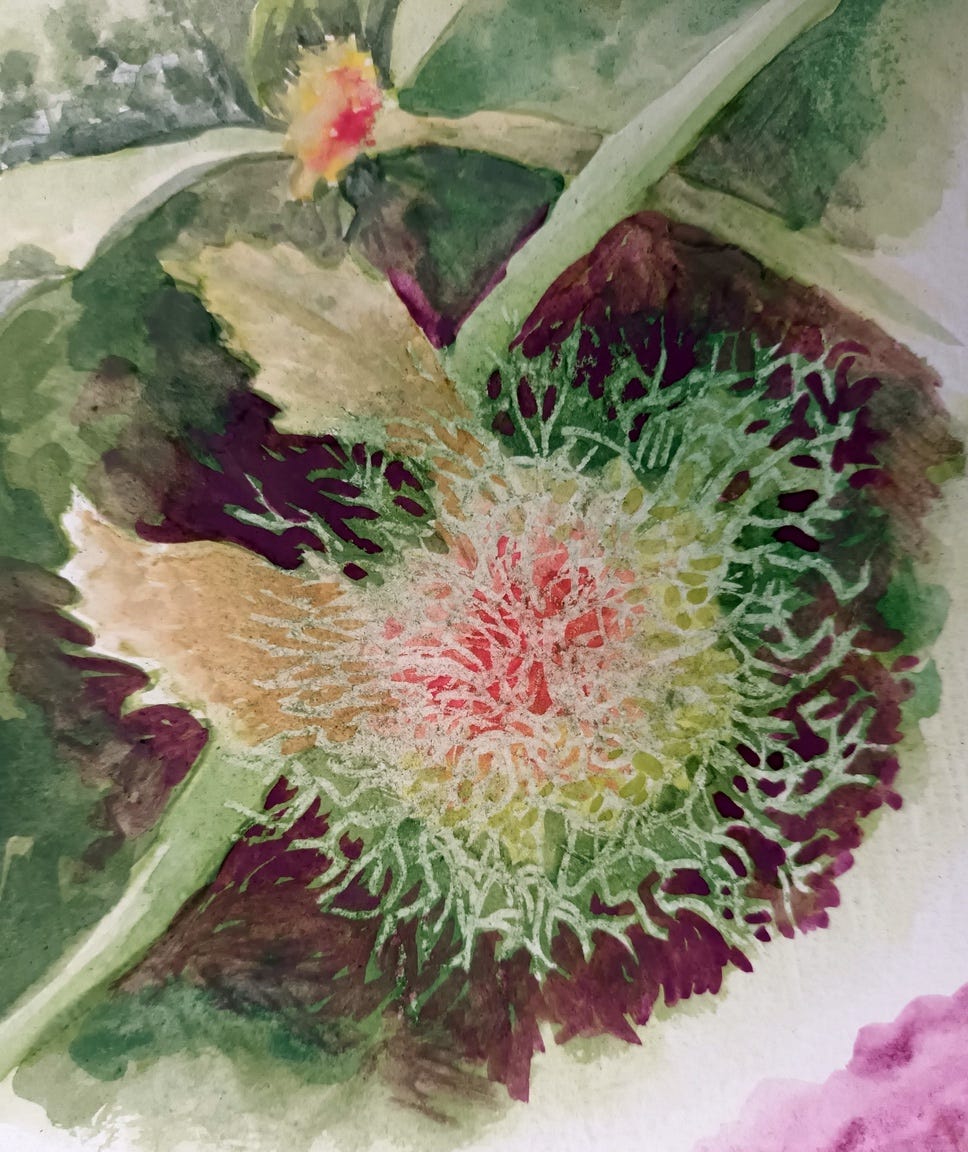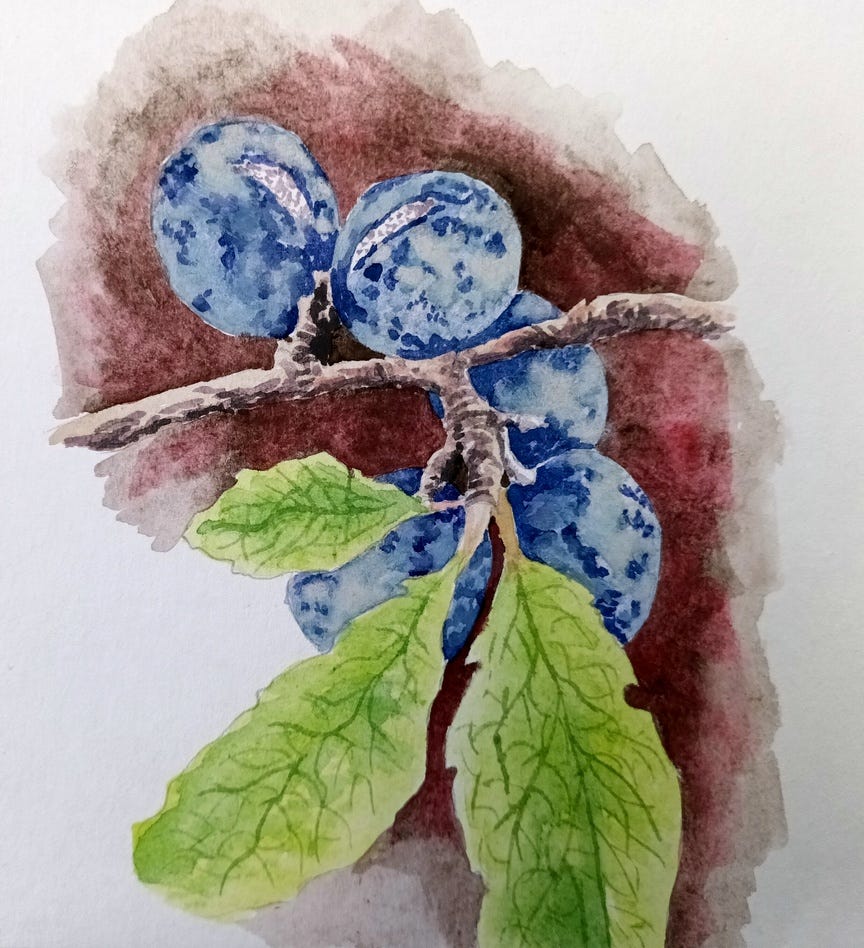The University of the Self #90
Birdsong, Botany and Betterness Part 20
Birdsong, Botany and Betterness Part 20
This article is a continuation of part 19, which can be found here.
Part 21 can be found here.

“I will be the gladdest thing
Under the sun!
I will touch ahundred flowers
And not pick one!
I will look at cliffs and clouds
With quiet eyes,
Watch the wind bow down the grass
And the grass rise.” (from ‘Afternoon on a Hill’ by Edna St. Vincent Millay)

8.47 a.m. Back. Still wonderfully mild. Lots of grey in the sky. Incredible sunbeams streaking down – rods of light – falling upon the houses at the top of Prudhoe, visible above the riverbank trees.
More Chicory has bloomed and one wonderful, tiny but vibrant Crimson Clover – only the size of a marrowfat pea but gleaming like a jewel in the grass.
Eurasian Linnet, Eurasian Wren, European Greenfinch, Goldcrest, Eurasian Blue Tit, European Goldfinch, Common Wood Pigeon.
Helicopter thrumming overhead has frightened all the Goldfinches from the field – the Wren calls its alarm – a cacophony of alarm calls. They are beginning to gentle down now the helicopter has become a distant rumble.
European Robin, Great Tit, Willow Warbler, Eurasian Tree Sparrow, Dunnock, Eurasian Blackbird. 9.08 a.m., Ring-necked Pheasant suddenly clucketing a few yards away – concealed apart from his voice. Is he advertising himself? 9.13 a.m.
12.01 p.m. Back. The sun is not bright and there is a breeze but the heat is still quite intense. I think more it is the stickiness I find difficult to tolerate. 12.26 p.m., starting to feel like rain.
Common Chaffinch, European Goldfinch, European Greenfinch, Common Wood Pigeon, Barn Swallow, Eurasian Jackdaw. Noticed a couple of Leafcutter Bees humming around the Wildflowers. Still a little dizzy and wobbly, but thankfully, after hydration, salts, magnesium etc., cramps have subsided, now just a tight ache. 13.30 p.m. I forgot to say as well – I have been assuming the far half of the field was all nettles – how wrong I was – and happy to be wrong and learn from it. My husband went over and brought me a couple of samples. The field on that half I know was sown with bird mix – and the tall green and yellowing plants are Goosefoot, a type of Quinoa, and Proso Millet. No wonder it is so full of birds.
“Sets of three sweet full notes, weaving into and out of each other like the
triplet rhymes in medieval poetry,
And the higher, purer notes of the tufted titmice among them,
High in the trees where they were catching what they could of the early sun.”
(from ‘Iowa City: Early April’ by Robert Hass)
19.00 p.m. – 8.15 p.m. (20.15 p.m. – I keep getting mixed up with the 24-hour clock). Just been for the most delicious walk – not far at all, but enough to visit some of the trees and plants en route – the sae route I’ve taken a few times, leg braces on, two trekking poles and we took a slow pace, better for noticing. Brambles absolutely loaded with blackberries – heavy, pendulous, sensual – some still red, some purple-black, some blossom still. Hawthorns laden with haws all along the roadsides. At the top of Coal Lane, a huge Blackthorn, absolutely bedizened with blue fruit. Elderberries in beaded bunches in various stages of ripeness. The one sad thing I have noticed roundabout is that many trees seem to have given up on summer – they are already autumning – already leaves turning golden – many leaves crisped around the edges with brown – is this a response to drought? That they must abandon their leaves in very dry weather in order to save themselves? How very heartbreaking if so. I notice the Russet Apple Tree on this route has no fruit on it this year. A bad sign.
Visited the Artichoke Galls on the small Oak – many Silk Button Galls on leaf undersides, each tiny gall holding one single wasp – a Neuroterus numismalis, according to research, agamic. How incredible galls are – that the original egg releases special chemicals which entirely transform a leaf, or acorn! It almost seems impossible, yet is entirely possible. We inspected all the trees and plants minutely and oh my goodness, another first for me, as we were looking at rosehips on the wild roses, a Rose Gall! Robin’s Pin Cushion, Rose Bedeguar Gall, Moss Gall, caused by the gall wasp Diplolepis Rosae. What an exquisite confection it was. How are these things even possible? I know the science but it strays into fairyland territory. Living art. Eggs are laid in the buds or on the leaves during summer. Apparently they are hard woody…


…structures with an outer covering of moss-like leaves. There was one large gall and two smaller galls on a leaf. I will be keeping an eye on these fascinating developments – I hope the rose doesn’t get cut down in the autumn when the tractor and hedge-cutter come. I am filled with magic! Magic through my entire mind and body. Less than a mile’s walk revealing so much. My heart was unprepared for this sudden influx of joy.
Today, the Leafcutter Bee on the decking has dropped a dozen leaves (like a beautiful currency – for being allowed to share your space, I shall pay you in delicately nibbled coins of green). All day it has carried leaves – every time it drops one, it does not pick it up – it goes and nibbles off a fresh piece. Twice I have rescued it from its spider neighbour’s webs with a spoon. Once it (the bee) nibbled at some web covering small opening in the plastic – I could hear the tiny sound of its biting. I have named it Leif (after Leif Erikson, the Norse explorer), as it is a very intrepid creature, searching for a home (I have since learned that this is how Leafcutter Bees make their nests – they form a long straw-like structure from curled leaves and lay a singe egg inside each straw). Now that I can recognise the species, I have seen them around in the wildflower crop. An amazing microcosm. When I think of my life as closing in, I will remember how much life has actually opened up for me. I must keep on learning how to balance the pain with bliss. And I must keep on sharing, keep on writing it down because somewhere, there are people who care. I can feel their kindred spirits. I know that they are there.
15th August 5.42 a.m. Front. A wonderful chill. Brisk breeze tussling The Seven – all their intricate sections of twig seem to be moving independently. Horizon tinged with palest lemon, everything else pale silver. An amazing, bright white half moon absolutely beaming south west, exactly like half a pill. The moon has decided it wants a share of the day. I read with immense sadness about a devastating fire on rare and precious heathland in Dorset – a fire which might have been started deliberately – leading to the incalculable loss of precious habitat, animals and native reptiles. So, so much to grieve for in this world, all human-caused. Perhaps this is why the moon is still so visible – it keeps a vigil above human cruelty, thoughtlessness and greed. It keeps vigil with the humans who do care – who know all life is precious, no matter where – with the humans who try to pass gently through this world. I am so very glad to be here with the birds and to partake in their simple love of the Earth.
A Eurasian Magpie hops and bounces on the caravan roof across the road – they are surprisingly heavy-footed. Common Buzzard keens from far off south west. I hear the chickens kept by the man at The Alders. The trunks of The Seven have turned impossibly orange in the growing light – the orange under and around their needles. I am learning the Redpoll’s voice. One pair of extremely loud European Herring Gulls heading west. One noisy Ring-necked Pheasant hen flying low over next door’s cottage, heading for the wildflower field.
Eurasian Blackbird, Carrion Crow, Long-tailed Tit,, Eurasian Jackdaw, distinctive Great Spotted Woodpecker, Eurasian Blue Tit, Eurasian Collared Dove, Barn Swallow, Great Tit, European Goldfinch, European Robin, Common Wood Pigeon, Dunnock, Goldcrest, European Greenfinch, Eurasian Wren. Rooks heading west, deep-gravel conversation. Common Chiffchaff. Joy, joy, joy – fist appearance of a Northern Lapwing, Eurasian Siskin.
Sun beginning to warm and blue the sky. Haws beaming like carnelian and coral. Eurasian Linnet, Willow Warbler, Eurasian Tree Sparrow, Common Redstart, Common Chaffinch. The purple Petunias in bloom like frilly blouse collars. Gray Wagtail. The air still has the taste of icy dawn in it. White Wagtail. A Pigeon preens on a branch on one of The Seven, readying its skirt-like tail for the day. House Sparrow. The moon has moved a little further west – it reluctantly passes on to another part of the world (and if it didn’t, how would there be another night?).

Eurasian Treecreeper. All I want to do is write about nature and paint pictures of nature. It seems valuable to do this. What is driving me on to do so, I don’t know. A Linnet flew over, its pink-peach breast showing. Eurasian Jay joins the throng. It feels as if this is the last important thing I can do – a small but positive act which my writing and art can perform. An act of quiet rebellion against the waste humans do. A Woodpecker knocks on a nearby tree – tap-tap-tap –, tap-tap-tap-tap-tap-tap. It has been knocking for maybe five minutes – will the tree let it in?
Red-legged Partridge. App produces Common Merganser but this I fear is incorrect. Willow Tit also, but also, sadly, not here. I think the Jay is waiting for me to go so it cam come and rake through my glass beads and marbles I have in an area of the front garden. It scatters them across the paving and takes them (I don’t say ‘steals them’ as birds don’t know about the human obsession with possession). Perhaps gives them away as gifts. Woodpecker still knocking. 6.54 a.m.

I read an article this evening about the difference humans have made to the butterfly population by not mowing their lawns so much and that was a comfort – two news articles today – one negative, one more positive.
16th August, 4.08 a.m. Front. Very dark still. Writing by torchlight (re-chargeable). It has rained during the night – very thankful for this. All is soaking, still dripping. I had to get up – sleep is a stranger again. I have felt nauseous all night, spinning. Aching thigh muscles. Lately, some very specific popping, cracking and pain at the point where the neck meets the shoulders, at the back. I move and crunch – a feeling of dislodging, sticking and pain. I have beaten the birds up this morning – not a sound from anyone, so that I have an undisturbed audience with the river – the Tyne is sweetly telling me the noise of its progress – its long, wet body is shooshing over the stones, ebbing and lipping, silvering against the banks, lapping and eddying. Strong scent of the water.
4.21 a.m., an alarm is ringing – and a 999 siren momentarily alarms over Prudhoe way – the alarm sounds move over Stocksfield way. The Oxeye Daisy petals beam in the dark with that special moth magic white flowers seem to have. The dark has ever so slightly lifted, but only the subtlest amount. The Seven are still fast asleep. The fresh, cool damp is helping me feel less sick. Who shall the first bird be? I shall sit here until I hear one then I may go and try to sleep, try to find a way to arrange the pillows into a degree of respite for my neck.
I have told the doctors / physio / orthotics about this and none of them have examined it – I have told them that it always feels too much of an effort to keep my head up, that my head feels much too heavy for my neck, that the noises it makes alarm me, as do the jolts, cracks and locks. But they can’t seem to be interested in it.
4.29 a.m., a Tawny Owl. 4.41 a.m., I was just thinking about how a river carries particles, atoms of every place it’s been. It’s a flowing map, a thread of landscape DNA. How old is the water in a river? How much of it was once sky? Is it young? Is all water ancient? Is the water prehistoric glacier melted ice age water that simply keeps condensing, evaporating, passing endlessly between ground and sky, perpetually recycling? I think I might be overtired.
4.47 a.m., still no birds except the very occasional owl call. Are the birds later as the year ages? Are their body clocks dependent on light?
4.51 a.m., the first day bird is a wonderful surprise – a Gray Heron wakes down by the river – one strong loud caaa! I am imagining its long body unfolding.
4.54 a.m., Common Wood Pigeon. I did say I would go back to bed but yes! The beautiful sea-whistle sound of Eurasian Oystercatcher, 4.56 a.m. How very fitting that my early birds are water birds. Still the murmuring of the river. European Robin, t-t-t-t- t-t- t-t-t-t. Hawfinch appears again. Maybe.
Please consider helping me to keep on sharing my articles with you…
I have currently left my Substack free, but if anyone should feel like sending me a tip (although there is no pressure to do so) in exchange for my tips,
you can ‘buy me a coffee’ here . Or here, if you would like to make a donation.
Every little bit makes a big difference. Or please do subscribe, which you can do either as paid or free. Either will let you see my articles. Many thanks.
If you like the article you have read, please do click the like button — I’d love to know you are out there.
I must add the usual disclaimer here: I am not sponsored or paid by any of the websites I link to (I do this in an attempt to help others find information, and I may or may not agree/disagree with any/some of the content) — sharing does not immediately equal endorsment. I also hope I haven’t written anyting that might offend anyone. I try very hard to be as considerate and kind as possible.

